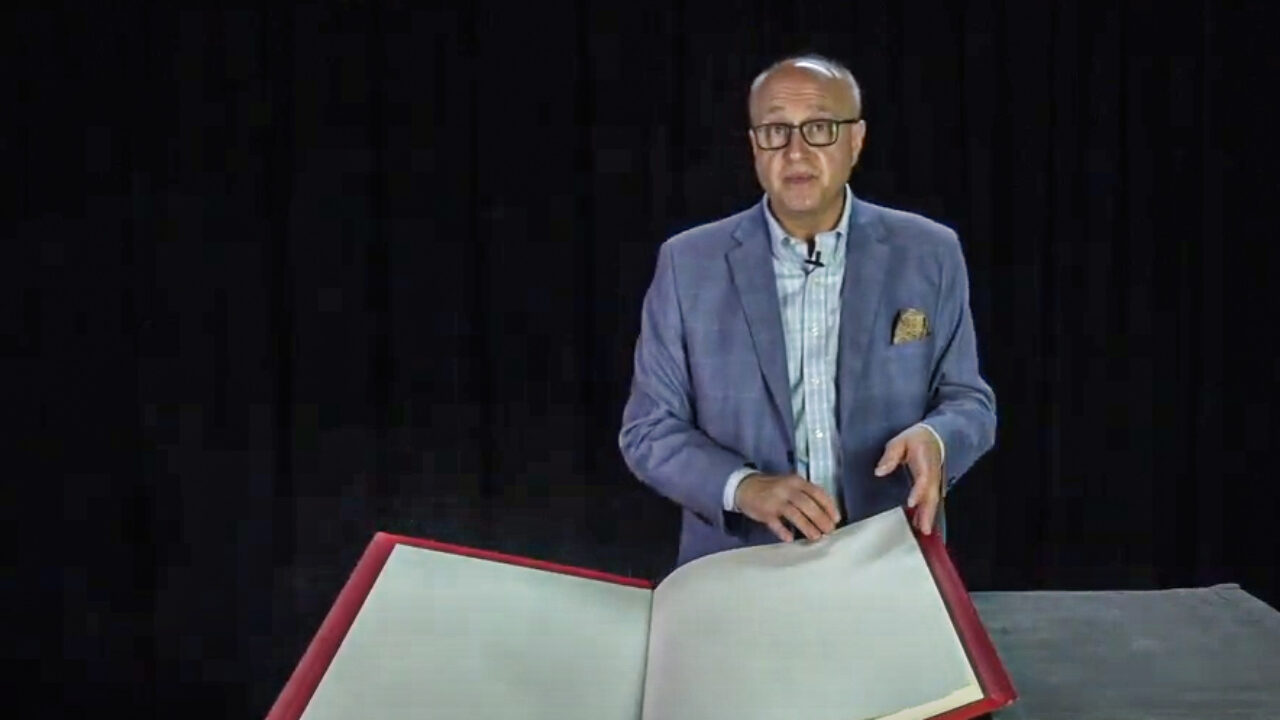How-To Care for Your Heritage Edition with Tim Ternes, Director of The Saint John’s Bible at the Hill Museum & Manuscript Library
Learn proper form for storing, handling, displaying, and sharing your Heritage Edition seven-volume set with Tim Ternes, Director of The Saint John’s Bible at the Hill Museum and Manuscript Library.
Heritage Edition sets of The Saint John’s Bible were made to be touched, held, paged-through, interacted with, and loved. Tim Ternes, Director of The Saint John’s Bible program at Hill Museum & Manuscript Library at Saint John’s University can’t emphasize that enough. The Heritage Edition was not meant to be put on a shelf or in a protective room and pulled out for special occasions.
However, your Heritage Edition set is special. And because of how it was printed and bound, as well as the nature of it being a holy publication, there are specific ways to care for it similar to how one might care for a U.S. flag or other sacred items.
For many years, Tim Ternes has acted as the primary caretaker of The Saint John’s Bible original manuscript. In his role, Ternes worked closely with the artistic team in the creation of the original Bible folios, and he travels extensively throughout the country and internationally, offering presentations and educational programs for The Saint John’s Bible and library collections.
In short, his expertise when it comes to the handling of and caring for The Saint John’s Bible is second to none.
In a video posted by the Hill Museum & Manuscript Library Youtube channel, Ternes shares an expert guide to using and caring for the Heritage Edition volumes in one’s own setting, whether that’s a faith community, a hospital, a library, or in one’s own home. The video touches on proper storage, handling, display, and sharing of The Saint John’s Bible Heritage Edition sets.
All that is to say, anyone can be an expert. If you adhere to the steps below, your Heritage Edition will remain in proper condition to be enjoyed for generations to come.
Storing the Heritage Edition
When it comes time to store the Heritage Edition volumes, there are crucial steps to take in order to keep them safe and protected. The key thing here is to control where the weight is being applied to the pages of the volume. The best option for long-term storage is to store the volumes flat in their own boxes on a single shelf. Stacking the volumes on top of each other should be avoided.
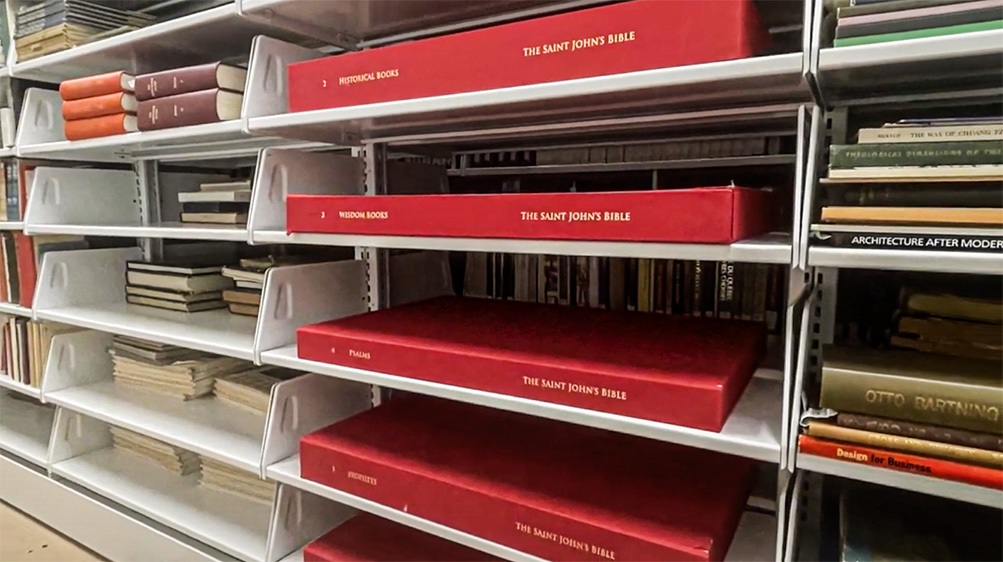
If there is a situation where the volumes must be stored vertically, they should be stored so that the spine is facing downward. This way, the weight of the volumes will be located towards the bottom and will not place any unwanted stress on the volume’s stitching.
The Saint John’s Bible Heritage Edition was designed with a special Yapp edge binding a limp, flexible edge that was invented in the 19th century. Over time, these edges slowly close over the pages to protect the text block underneath. So, if the edges of your Heritage Edition volumes are closing from use, that is entirely normal and even something to celebrate.
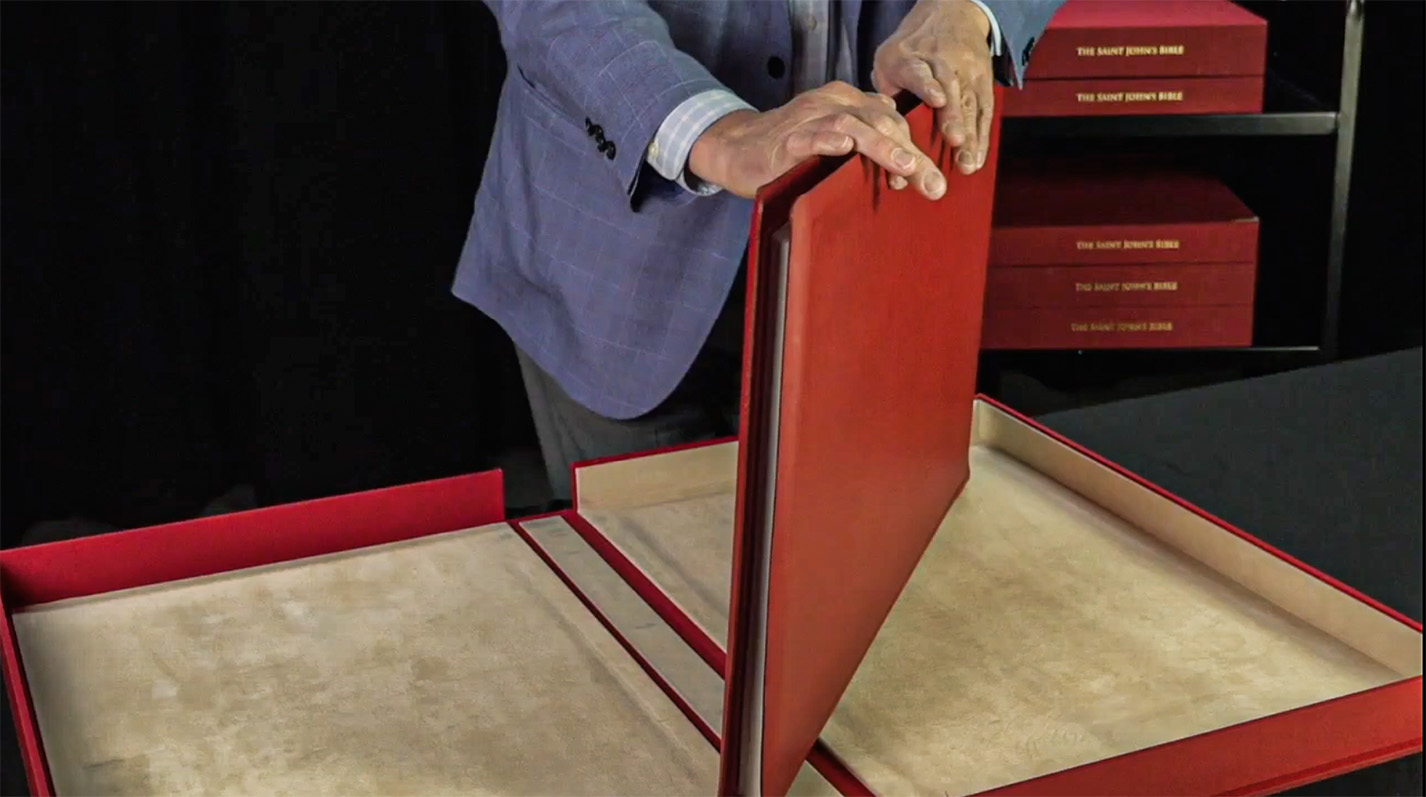
Optimal Storage Conditions:
-
- 68 degrees Fahrenheit (+/-5)
- 45% relative humidity
- If you cannot provide the optimal temperature and humidity levels, work to avoid extreme or frequent changes in both. Consistency is key.
- Store the volumes flat and on individual shelves not stacked.
- Avoid direct sunlight or prolonged, direct high levels of artificial light.
- Minimize or eliminate UV exposure.
Handling the Heritage Edition
Believe it or not, handling a volume of the Heritage Edition with your bare hands is the recommended technique. A common misconception when it comes to handling delicate books and pages is that one must wear gloves. However, you can do far more damage to the book by using gloves than you can with the oil and soil on your hands.
Gloves have chemical makeups that can interact poorly with certain kinds of paper. So, they should be avoided when handling any kind of paper except for photograph paper.
The best technique for handling the volumes is simple: wash your hands with soap and water and dry your hands carefully. Avoid using hand sanitizers or wipes as they contain chemical moisturizers that can leave residue on the pages.
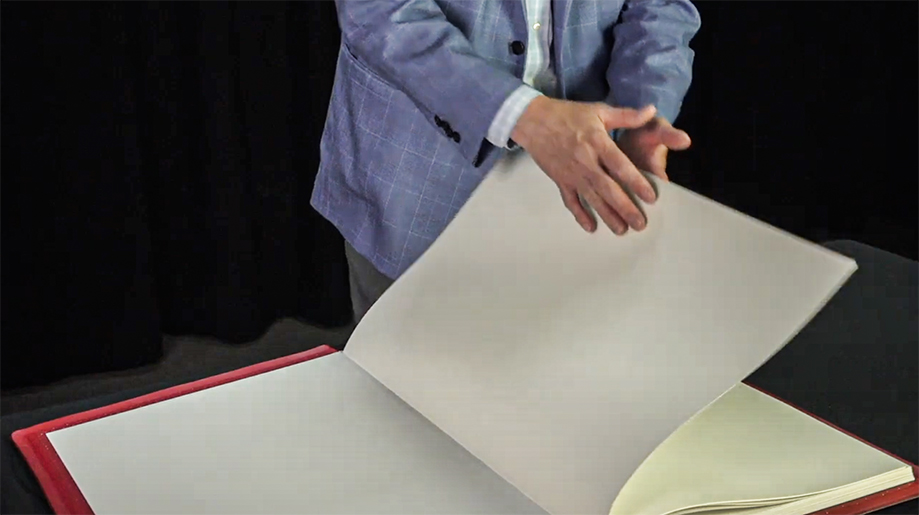
Additionally, the pages of the Heritage Edition are large and should be supported when turning the pages. You should always lift the pages from their corners, placing one hand at its center to guide the way. This helps turn pages gracefully and easily, allowing the weight of the page itself to let it fall naturally.
Avoid lifting pages and fanning them when trying to find a specific page. Bending and fanning the pages can cause dimpling and crimping which, over time, will damage the fibers in that spot, break them down, and create a hole.
Displaying the Heritage Edition
Due to its volume and size, there are specific things that you need to consider when planning a short term display of a single volume of your Heritage Edition. The key to careful displays is to limit the amount of stress that is being placed on the binding of the book itself. The structure and design of the Heritage Editions were designed with longevity in mind, and placing undue stress on the binding structure can accelerate the work’s aging process.
Think of your own body. When you go to pick up and hold a heavy object for a long time, you’ll start to feel an ache seep into your muscles the very same thing happens to the binding of a book. Primary stress points on the volume are the headband, the tops and bottoms, and the smaller areas along the binding where the stitches hold the text block to the spine. The recommended angle for long term display is 15 degrees; no more, no less.
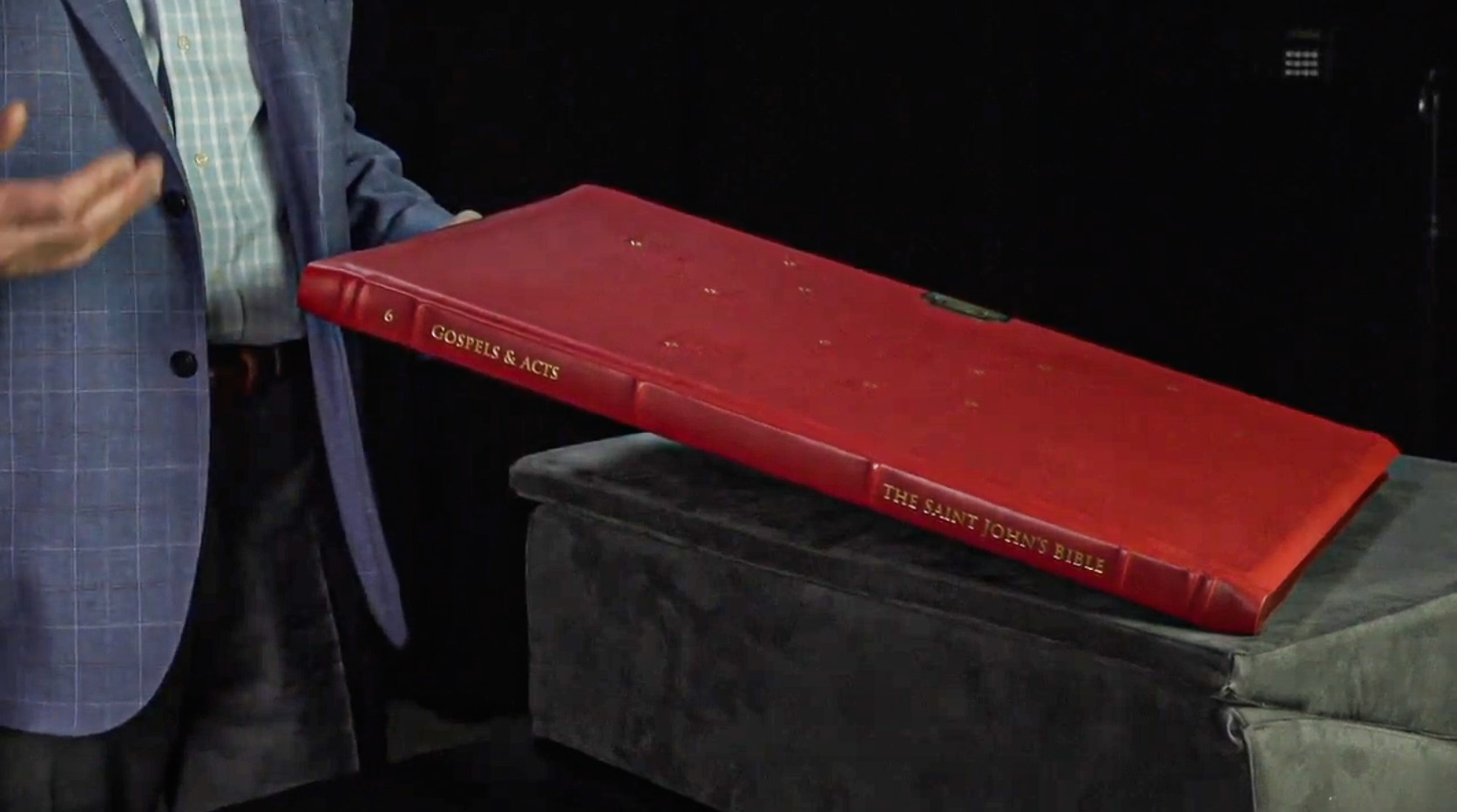
There are various ways to support the volumes when they are on display. For example, 180-degree angles should be avoided, so it’s best to use an appropriate stand that supports the full length of your Heritage Edition. When acquired, there is a stand given with your Heritage Edition that is wonderful for use when sharing volumes with a large audience. This stand is accessible and supports the volumes nicely so you can open and turn pages for guests with ease. These stands are most appropriate for short term temporary use as opposed to long term display.
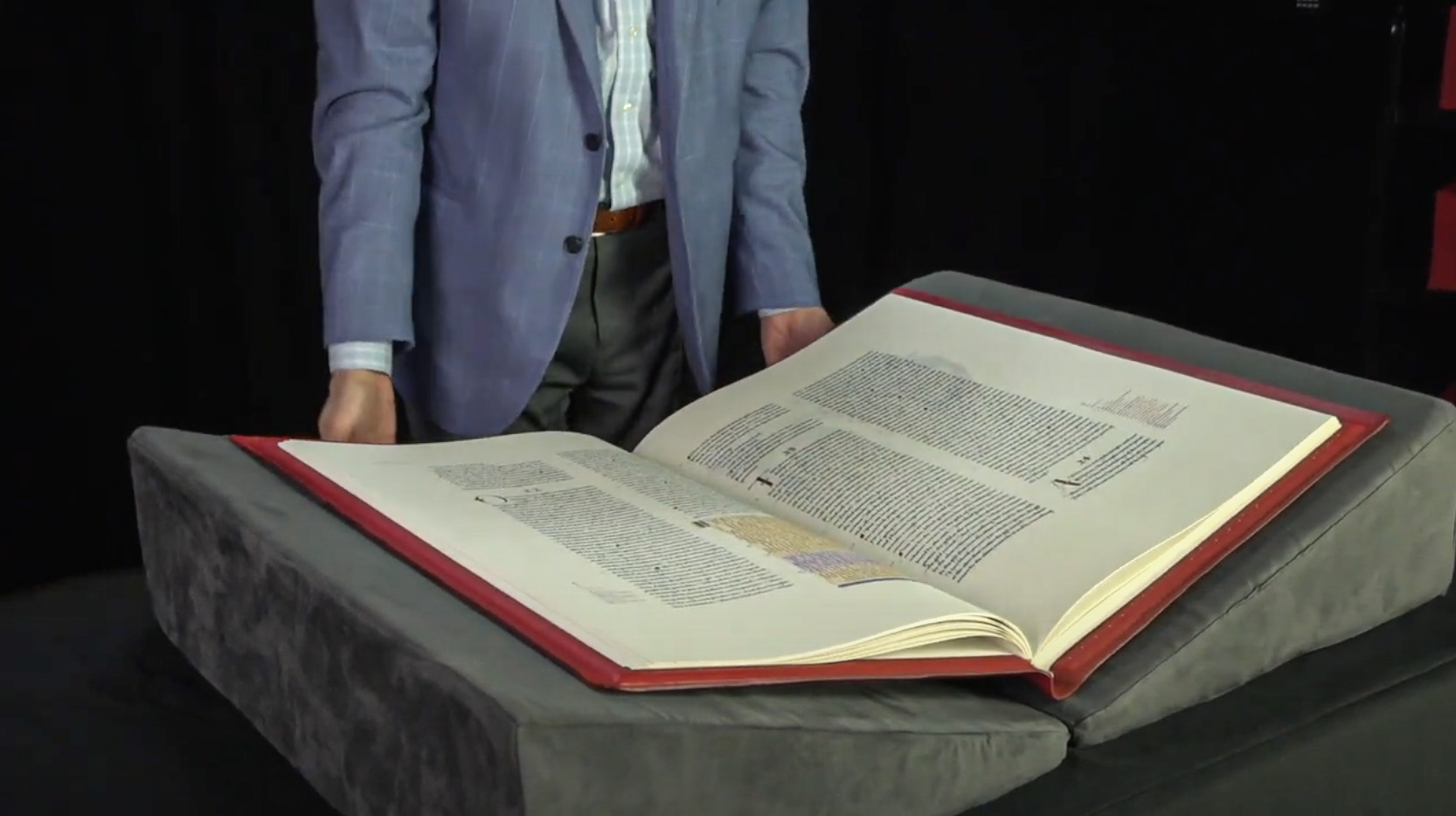
Long term displays require support for the full-size of the manuscript at the proper opening angle. Saint John’s uses a Clarkson Book Mount, which is a foam pillow set that creates the perfect bed to support an entire volume.
When in doubt listen to your book, it will tell you how far it wants to open up. Don’t force it.
Sharing the Heritage Edition
The Saint John’s Bible was created for the purpose of being shared with others, and you are encouraged to make them as accessible to others as possible. At Saint John’s, Ternes encourages guests to interact with and turn the pages on their own. However, there are a few things to keep in mind when interacting with the work.
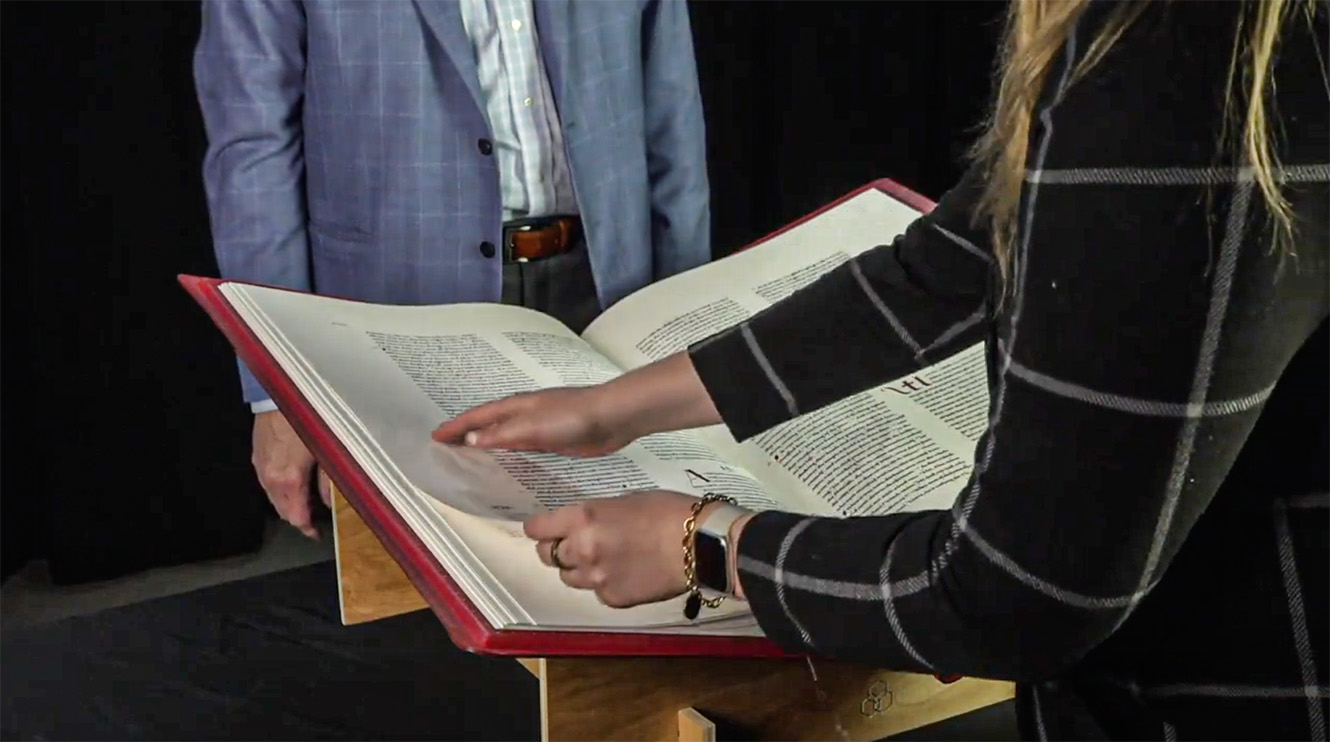
Keep in mind:
- When guests arrive, remind them to wash their hands with soap and water, and to dry them carefully before touching the pages.
- Sharing the volume on a large table not only supports the books, but it also creates space between guests and the edge of the table. This distance keeps guests at an appropriate distance so they are not standing directly above the pages.
- Demonstrating to guests how to handle the book is important so they can see the care with which one should turn and handle the pages.
- As a host, gentle reminders are helpful so that guests can avoid making any unwanted, abrupt contact with the pages if they are wearing any loose sleeves, jewelry, and other dangling material.
Most Importantly: Use the Volumes
Remember, the most damaging thing one could do is to not to use the Heritage Edition. As a living work of art, the pages must stretch and breathe. So, take it off the shelf, and share it with as many people as possible. Use the volumes to connect with others and encourage others to share it as well. With care and thoughtful planning, the volumes will be enjoyed across the globe for centuries to come.
The Saint John’s Bible Heritage Program: Engaging the Modern Living Word of God
For more information on handling and caring for your Heritage Edition, or any other inquiries about The Saint John’s Bible Heritage Edition and original manuscript, contact Tim Ternes at tternes@csbjsju.edu
To read more stories similar to this one, subscribe to the Heritage Program’s monthly e newsletter, Sharing the Word, or visit the blog.


